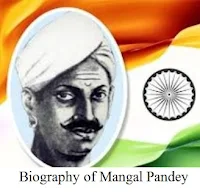Biography of Mangal Pandey:
Mangal Pandey was a key figure in the Indian Rebellion of 1857, also known as the Sepoy Mutiny or the First War of Independence against British rule in India. Born on July 19, 1827, in Nagwa, a village in present-day Uttar Pradesh, Mangal Pandey served as a sepoy (soldier) in the British East India Company's army.
 |
| Biography of Mangal Pandey |
Some key points about Mangal Pandey's life and role in the Indian Rebellion of 1857:
1. Early Life of Mangal Pandey:
Mangal Pandey joined the British East India Company's army in 1849 and became a sepoy in the 34th Bengal Native Infantry. Not much is known about his early life, but he was likely influenced by the social and political changes of the time.
2. Introduction of the New Cartridge:
The events leading to the rebellion were sparked by the introduction of the new Enfield rifle cartridges. The cartridges were rumored to be greased with a mixture of pig and cow fat, which offended both Hindu and Muslim soldiers due to religious reasons. To load the rifle, soldiers had to bite the cartridge open, leading to concerns about the contamination of their religious beliefs.
3. Revolt at Barrackpore:
On March 29, 1857, Mangal Pandey rebelled against his British officers at Barrackpore. He attacked two British officers, Lieutenant Baugh and Sergeant-Major Hewson, but was subdued and arrested.
4. Trial and Execution:
Mangal Pandey faced a court-martial for his actions. He was tried on April 6, 1857, and was sentenced to death. On April 8, 1857, Mangal Pandey was hanged at Barrackpore. His execution served as a catalyst for the widespread uprising that followed.
5. Mangal Pandey as Symbol of Resistance:
Mangal Pandey's actions and sacrifice made him a symbol of resistance against British rule. His courage and defiance inspired many others to join the rebellion.
6. Impact on the Rebellion:
The rebellion that began with Mangal Pandey's actions spread rapidly across northern and central India. It marked a turning point in India's struggle for independence, leading to a widespread uprising against British rule.
Mangal Pandey's legacy is remembered in Indian history as a symbol of courage and the initial spark that ignited the larger movement against British colonialism. His role in the events of 1857 has been portrayed in various books, films, and other cultural works as a symbol of resistance and the fight for freedom.